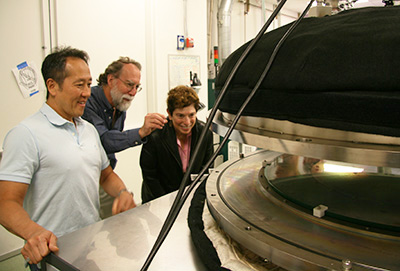UC Santa Cruz researchers is working with Structured Materials Industries to design and build an atomic layer deposition (ALD) system large enough to accommodate telescope mirrors. To be specific they will deposit a protective optical coating for large silver-based telescope mirrors by ALD.
Left: The summit of Mauna Kea is considered one of the world's most important astronomical viewing sites. The twin Keck telescopes are among the largest optical/near-infrared instruments currently in use around the world. Middle: The night sky and Keck Observatory laser for adaptive optics. Right: W. M. Keck Observatory at sunset (Wikipedia)
UC Santa Cruz Reports: The new system was delivered to Kobayashi's laboratory in July, 2017 and has performed well in initial testing. The researchers will use the system to demonstrate that it works for telescope mirrors and other large substrates and to continue perfecting the coatings. The system can accommodate a mirror up to 0.9 m in diameter, and there is no reason the design could not be scaled up to accommodate larger mirrors or mirror segments, Phillips says. The 10 m primary mirrors of the twin Keck Telescopes in Hawaii are composed of hexagonal segments 1.8 m across, and the mirror segments for the Thirty Meter Telescope (TMT) will be 1.4 m across.
The Astronomical ALD system will be used to deposit protective coatings on silver-based telescope mirrors (Picture from UC Santa Cruz).
Source: UC Santa Cruz (LINK)
UC Santa Cruz Reports: The new system was delivered to Kobayashi's laboratory in July, 2017 and has performed well in initial testing. The researchers will use the system to demonstrate that it works for telescope mirrors and other large substrates and to continue perfecting the coatings. The system can accommodate a mirror up to 0.9 m in diameter, and there is no reason the design could not be scaled up to accommodate larger mirrors or mirror segments, Phillips says. The 10 m primary mirrors of the twin Keck Telescopes in Hawaii are composed of hexagonal segments 1.8 m across, and the mirror segments for the Thirty Meter Telescope (TMT) will be 1.4 m across.
The Astronomical ALD system will be used to deposit protective coatings on silver-based telescope mirrors (Picture from UC Santa Cruz).
Source: UC Santa Cruz (LINK)



%20(1).png)


No comments:
Post a Comment